Best Single Board Computers of 2025
It has been an exciting year for single-board computers (SBCs) in 2023. Just in June, NVIDIA launched the NVIDIA Jetson AGX Orin Developer Kit, which is their most powerful SBC to date. The Raspberry Pi 4 still reigns supreme for most users as the most well-known low-cost SBC, but we have a few more alternatives listed that you may want to consider in this article!
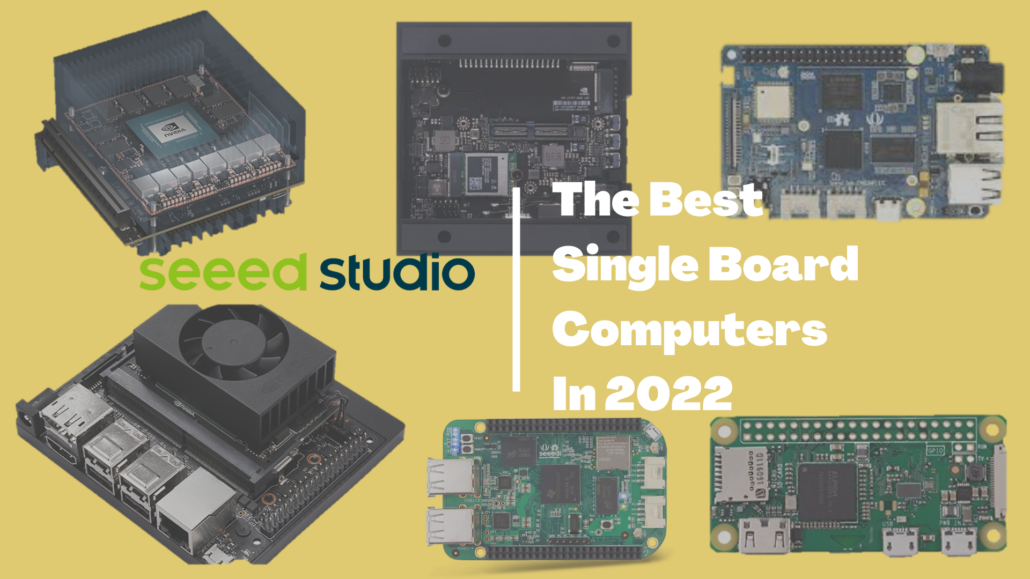
We have compiled all the best SBCs currently as of July 2022 and have categorized them based on individual strengths like cost, community, performance, simplicity, power consumption, and many more!
We will be keeping a close lookout for new single-board computers that are getting released throughout this year and continuously update this list! So do not worry as this guide will be constantly updated with regard to the latest trend and provide you with up-to-date information on which SBC suits you best!
Without further ado, let us jump right into the first and most popular SBC!
Best for Beginners: Raspberry Pi 4
Are you a beginner looking to start learning electronics with an SBC? With one of the biggest communities and support for development, the Raspberry Pi 4 is highly recommended for beginners and has become a must-buy for all makers and tech enthusiasts.
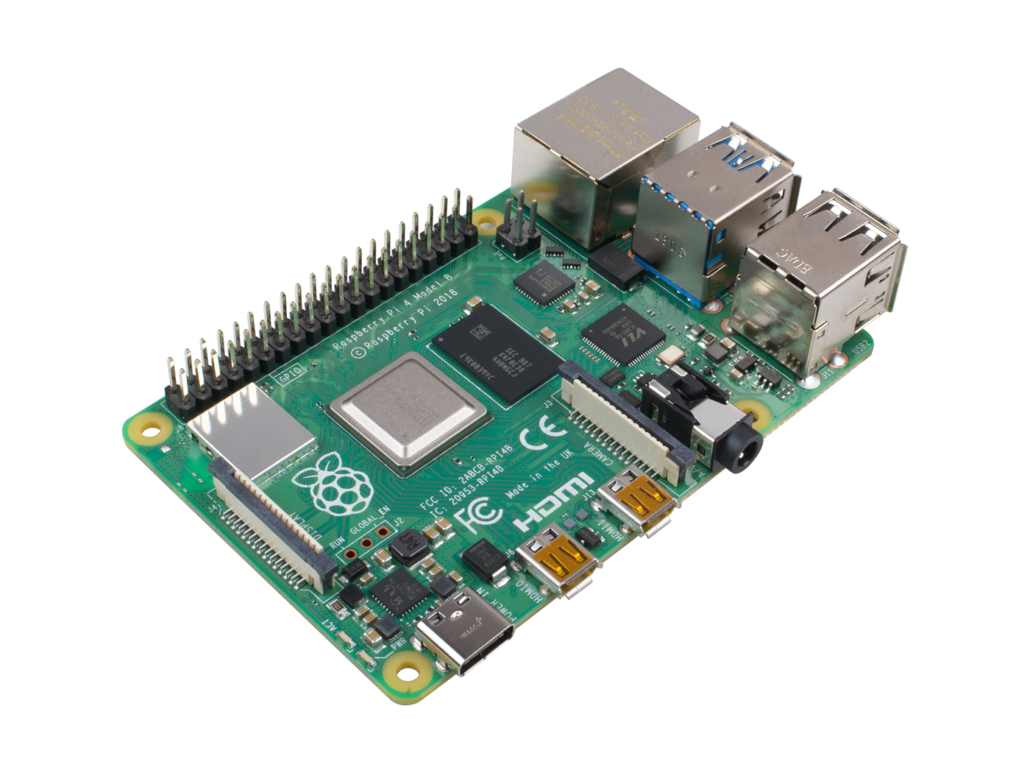
The Raspberry Pi 4 is commonly used by many makers, and there are many detailed tutorials and projects using the Raspberry Pi 4 which are well documented online. The new Raspberry Pi 4 features impressive speeds and performance power compared to previous models while staying affordable at the same price as the previous Raspberry Pi Model 3B+ of $35.
When it was released in 2019, the Raspberry Pi 4B only came in 1, 2, and 4GB RAM variants. In 2020, the Raspberry Pi Foundation released an updated version with 8GB of RAM, making the Pi 4 an even stronger candidate for tasks that require more memory. At its price, it features a Broadcom BCM2711, quad-core Cortex-A72 (ARM v8) 64-bit SoC @ 1.5GHz, which has a Video core VI Graphics Processing Unit (GPU) handling all graphical input/output. With it, it can cope with 4K resolution and H.265 video, as well as video scaling, camera input, and all HDMI and composite video outputs. The 2711 also has ‘proper’ USB3.0 and Gigabit Ethernet interfaces!
Feel that your Raspberry Pi 4 is still slow for you? It is also compatible with the Coral USB Accelerator at a price of $74.99 to further improve its machine learning capabilities and performance! Even though it is not the most powerful, most compact, or cheapest, it is definitely still recommended due to its community and support, which are very suitable for beginners just starting out on SBCs!
If you are interested in what the Raspberry Pi 4 can do, you can check out our other guides on:
- Top 20 Raspberry Pi 4 Projects That You Must Try now!
- Building Your Own Raspberry Pi 4 Retro Game Console with Retropie
- How to build a Raspberry Pi 4 NAS Server? – Samba and OMV
Raspberry Pi 4 Specs:
CPU: Broadcom BCM2711, 4-core Cortex-A72 (ARM v8) 64-bit SoC 1.5GHz
GPU: Broadcom VideoCore VI
RAM: LPDDR4 SDRAM
Price: $35 (1GB), $45 (2GB), $55 (4GB), $75 (8GB)
Buy now at Seeed’s online store!
Most Affordable: Raspberry Pi Zero / Zero W
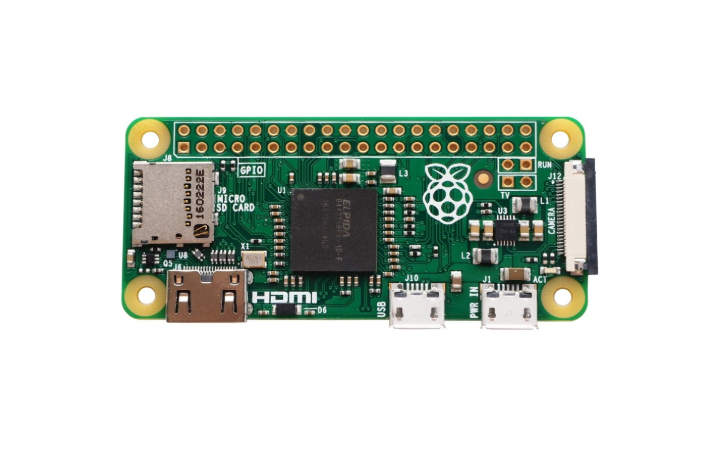
Want to get an SBC and not break the bank for it? Or having space constraints with your projects? If that is the case, the Raspberry Pi Zero / Zero W will definitely suit your needs! Costing less than your average movie ticket at $5 and $10, respectively, for the Raspberry Pi Zero or Zero W, it is one of the cheapest SBCs out there while offering decent performance. In addition, standing at only 65mm x 30mm x 5mm, the Pi Zero / Zero W size small size makes it very convenient for makers to include in their projects. They have found their way inside security cameras, robots, and even laptops!
Do you need Wi-Fi connectivity or Bluetooth? Get the Raspberry Pi Zero W which includes 802.11 b/g/n wireless LAN, Bluetooth(R) 4.1, and Bluetooth Low Energy (BLE) for your Wi-Fi and Bluetooth connection needs! With its price, you will definitely not find the best performance and power compared to other SBCs out there! It also lacks all the USB ports and audio jack found on the Raspberry Pi 4. How about extra connectivity? You can easily solder on a 2*20 Pin Male & Female header which brings the ability to plug in Pi HATs, GPIO cables, etc, like a regular Raspberry Pi!
Raspberry Pi Zero / Zero W Specs:
CPU: 1GHz, Single Core
GPU: –
RAM: 512MB
Price: $5 / $10
Get yourself one at Seeed’s online store now!
For HMI(Human-Machine Interface ) IoT projects: reTerminal CM4104032
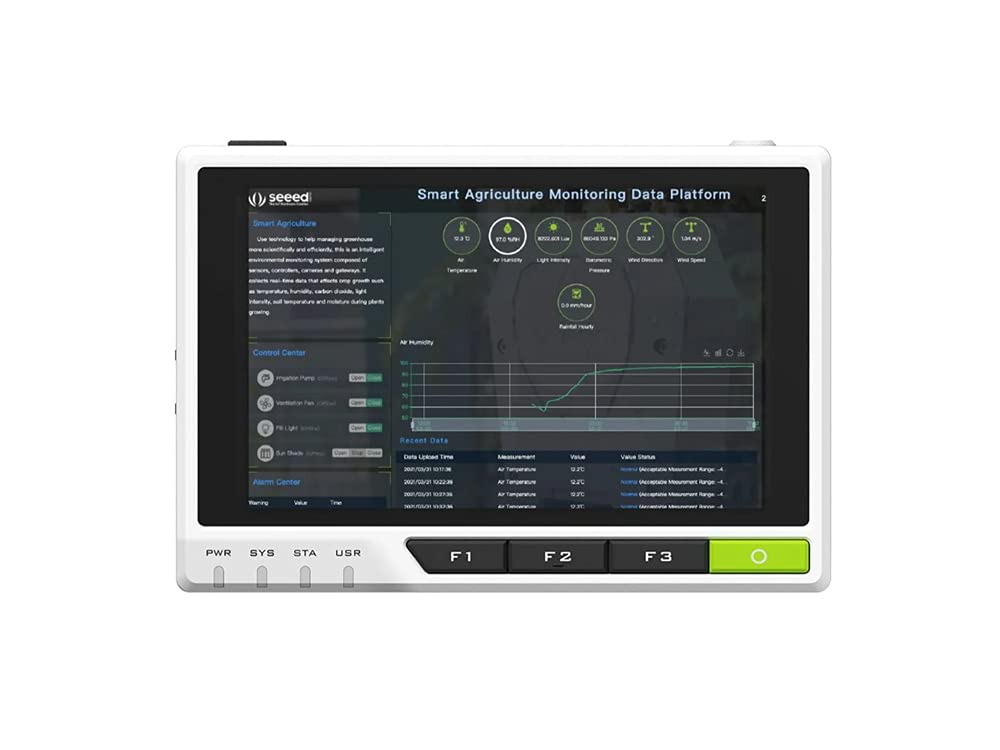
reTerminal is powered by a Raspberry Pi Compute Module 4 (CM4), which is a Quad-Core Cortex-A72 CPU running at 1.5GHz and a 5-inch IPS capacitive multi-touch screen with a resolution of 720 x 1280. It has a sufficient amount of RAM (4GB) to perform multitasking and also has a sufficient amount of eMMC storage (32GB) to install an operating system, enabling fast boot-up times and a smooth overall experience. It has wireless connectivity with dual-band 2.4GHz/5GHz Wi-Fi and Bluetooth 5.0 BLE.
reTerminal CM4104032 consists of a high-speed expansion interface and rich I/O for more expandability. This device has security features such as a cryptographic co-processor with secure hardware-based key storage. It also has built-in modules such as an accelerometer, light sensor, and an RTC (Real-Time Clock). It also has a Gigabit Ethernet Port for faster network connections and also has dual USB 2.0 Type-A ports. The 40-pin Raspberry Pi compatible header on the reTerminal opens it for a wide range of IoT applications.
reTerminal CM4104032 Specs:
CPU: Broadcom BCM2711 4-core Cortex-A72 (ARM v8)
RAM: 4GB LPDDR4 with on-die ECC
Price: $195
Get yours now on Seeed’s online store!
Best for Soft Router Applications: Mini Router with Raspberry Pi CM4
A router is a piece of hardware that connects a Local Area Network to other networks. In most cases, this “other network” is known as a Wide Area Network or none other than the Internet. The router is very much the “administrator” of this local network and plays an important role in managing connected devices.
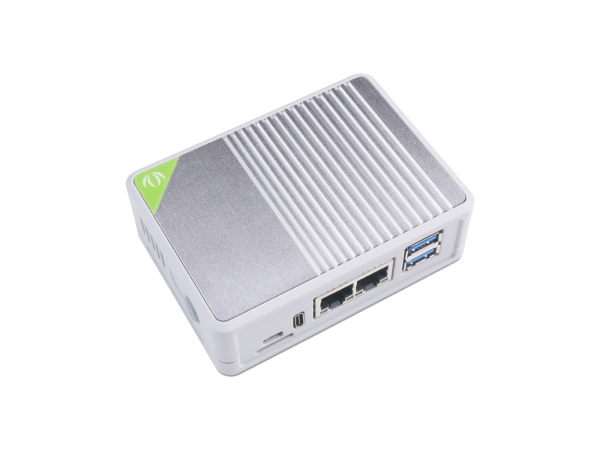
The Mini Router is equipped with dual Gigabit Ethernet ports and dual USB 3.0 ports, making it suitable for soft router applications while keeping the hardware to a minimum, only 75x64x21 mm in size. A Raspberry Pi Compute Module 4 with 4GB RAM and 32GB eMMC is preinstalled to enable fast boot-up times and a smooth overall experience. A DIN rail mount and keyhole slot allow you to hang it anywhere, which allows for easy and stable deployment. It is also preinstalled with OpenWrt, so you can just unbox the package, connect to your existing home network and have your own mini router!
Get yours now today on Seeed’s online store for only $149!
Why choose Raspberry Pi 4 for the home router?
1. Increase Network Bandwidth and Performance
While the Raspberry Pi is definitely weaker in comparison to a full-fledged desktop or laptop, its Broadcom CPU is certainly more than enough when it comes to network routing. Thus, a Raspberry Pi router will surely boost your network and give you greater internet speeds!
2. Improve Network Security
With a Raspberry Pi Router, you’ll be able to choose from free, open-source operating systems like OpenWrt that are community reviewed and maintained for security!
3. Enjoy Additional Features
With the accompanying hardware and I/O, using a Raspberry Pi as a router grants you flexibility in adding more features.
Raspberry Pi Alternatives
The Raspberry Pi is definitely one of the most popular SBCs around the world. But it’s definitely not the only one, with other manufacturers adding more powerful and feature-rich options to their products. If you’re interested in the Raspberry Pi but are not sure if it’s the right choice, here are the best Raspberry Pi alternatives for you to consider.
Raspberry Pi 4 Alternative: ODYSSEY STM32MP157C
The ODYSSEY STM32MP157C is based on the STM32MP157C, a dual-core Arm-Cortex-A7 operating at 650Mhz. It also integrates an Arm Cortex-M4 coprocessor, which makes it suitable for real-time tasks. This powerful board shares the same form factor and has the same 40-pin GPIO as the Raspberry Pi 4, making it compatible with many of your favorite accessories and HATs.
The ODYSSEY STM32MP157C is unique for its SoM (System on Module) plus carrier board design, which makes the applications you develop with this SBC easily scalable for deployment in embedded systems.
In addition, it comes with two grove connectors for convenient interfacing with the Grove ecosystem of sensors and modules.
Odyssey STM32MP157C Specs:
CPU: Dual-core Arm Cortex-A7 @ 650MHz with Arm Cortex-M4 Coprocessor
RAM: 512MB DDR3 RAM
Price: $54.90
Raspberry Pi 4 Alternative: Rock Pi 4 Model B
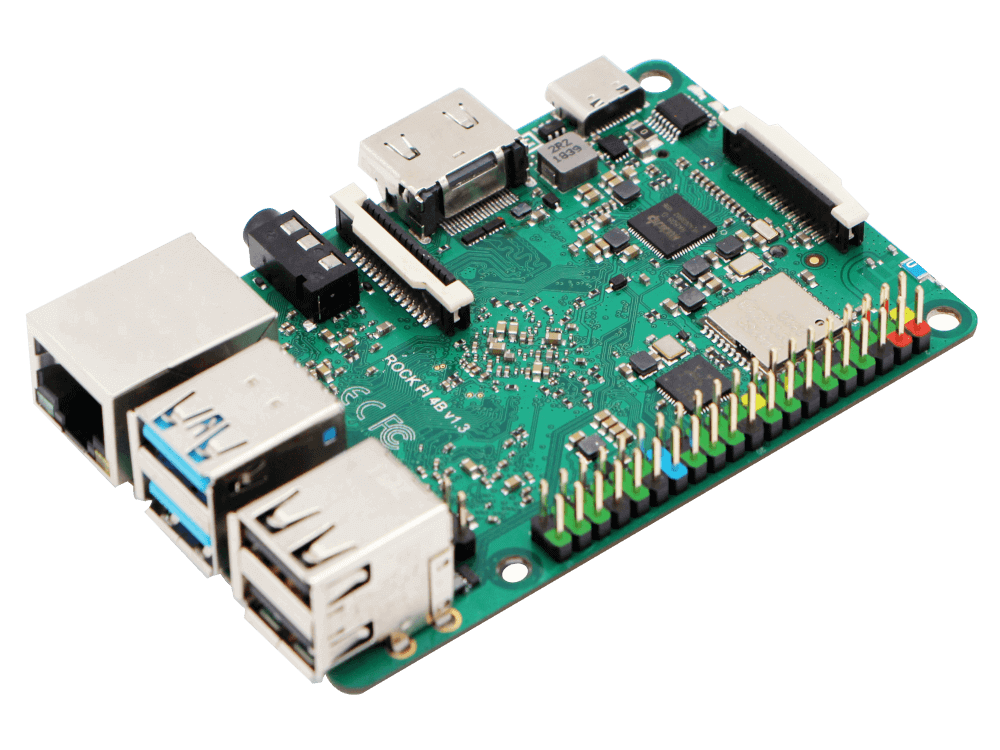
Compared to the Raspberry Pi 4, the Rock Pi 4 offers a better-performing CPU and GPU that is better suited for machine learning. The measurements, layout, and design are exactly the same as the Raspberry Pi 4, making it a formidable alternative to consider.
It is able to run Android OS officially and supports mainstream AI stack with GPU acceleration which is good for computer vision applications, robotics, etc. In addition, Rock Pi 4 has multiple storage options and features a better read and write performance on external storage drives, which allows for quicker read and write speeds that result in improved workflows and file usage efficiency.
However, community and support are not as robust compared to the Raspberry Pi as the community is smaller. Debugging may be a problem for beginners and novice users as documentation may not be as good. It also comes with a slightly more expensive price tag of $49 to $75 compared to the Raspberry Pi 4 at $35 to $55, depending on the RAM.
Rock Pi 4 Model B Specs:
CPU: Dual Cortex-A72 @ 1.8Ghz with Quad Cortex-A53 @ 1.4Ghz
GPU: Mali T860MP4 GPU, supports OpenGL ES1.1/2.0/3.0/3.1/3.2, Vulkan 1.0, OpenCL 1.1/1.2, DX11
RAM: 64bit dual channel LPDDR4@3200Mb/s, 1GB, 2GB, 4GB options
Price: $49 (1GB), $59 (2GB), $75 (4GB)
Raspberry Pi 4 Alternative: Banana Pi M64
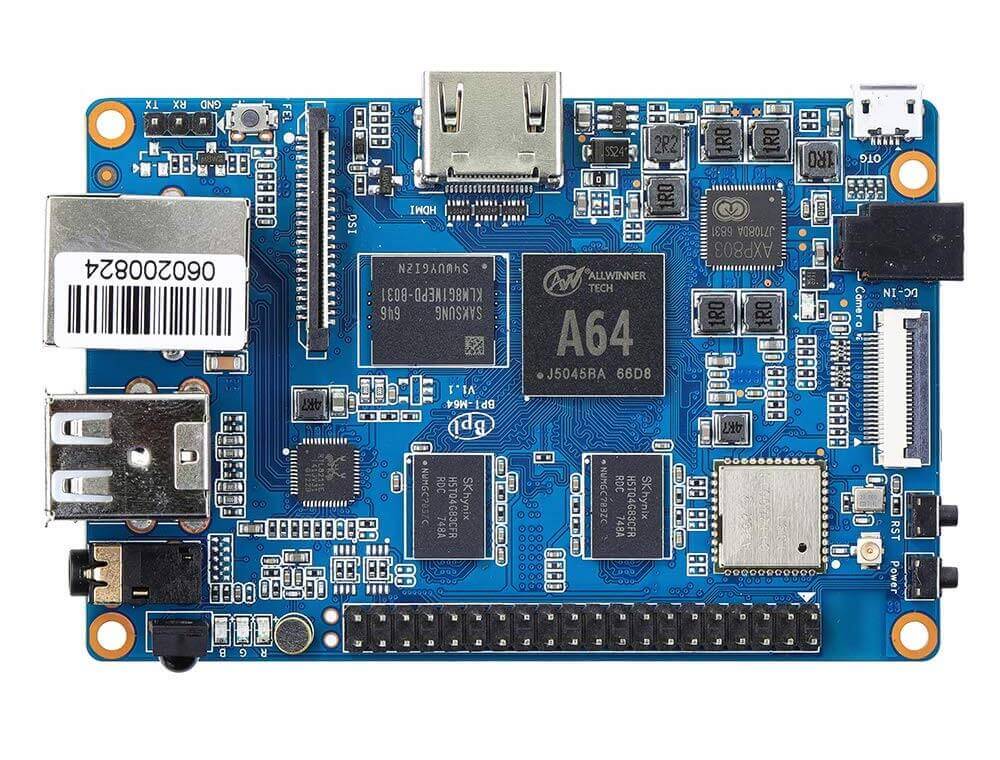
The Banana Pi M64 comes with 8 GB of eMMC, which is the main feature that differentiates it from the Raspberry Pi 4. It also features a 4K HDMI interface, MIPI-DSI, and MIPI-CSI, as well as onboard wireless and Gigabit Ethernet for your connectivity needs.
Despite being a Raspberry Pi 4 alternative, the community and users are not as robust compared to the Raspberry Pi 4 with a bustling community. With minimal tutorials and projects for you to choose from and learn from, beginners may face difficulties as debugging may be a problem due to the documentation not being as good compared to the Pi 4.
Banana Pi M64 Specs:
CPU: Allwinner 64-bit Quad-core ARM Cortex A53 @ 1.2GHz
GPU: Dual-core Mali 400 MP2
RAM: 2GB
Price: $60
Raspberry Pi 4 Alternative: Orange Pi 4B
The Orange Pi 4 is the update to the Orange Pi 3, with a 6-core ARM 64-bit processor comprising Dual-core Cortex-A72 and Quad-core Cortex-A53 and total clock speeds of up to 2.0GHz. The Orange Pi 4 has now been updated to have 40 GPIO pins like the Raspberry Pi and is suitable for similar applications like building a PC, media center, or retro game console.
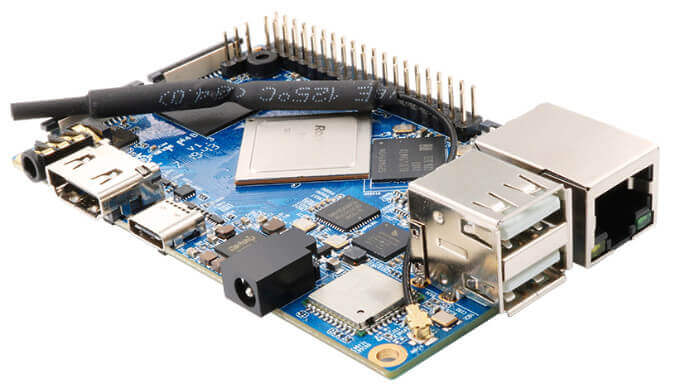
Orange Pi is a direct competitor to the Raspberry Pi, featuring slightly more powerful hardware specifications. It also has support for a variety of operating systems, including Android, Ubuntu, and Debian.
Despite being open source like the Raspberry Pi and packing more power, the Orange Pi isn’t as popular in the community. This means that there won’t be as many materials and projects to reference, so this might not be the best choice for beginners. It’s also slightly more expensive, coming in at $88 compared to $55 for the same amount of RAM.
Orange Pi 4B Specs:
CPU: Rockchip RK3399 6-core ARM® 64-bit processor, up to 2.0GHz
GPU: Mali-T864, Supports OpenGL ES1.1/2.0/3.0/3.1, OpenVG 1.1, OpenCL, DX11, AFBC
RAM: Dual 4GB LPDDR4
Price: $88 on Amazon
With many alternatives for the Raspberry Pi 4, do note that if you prefer stability, support, and projects that are well-documented for you to pick from, the Raspberry Pi 4 is recommended!
However, if you prefer more power or other specific functions offered, you can consider the alternatives.
Best for AIoT: NVIDIA® Jetson Nano™ Developer Kit
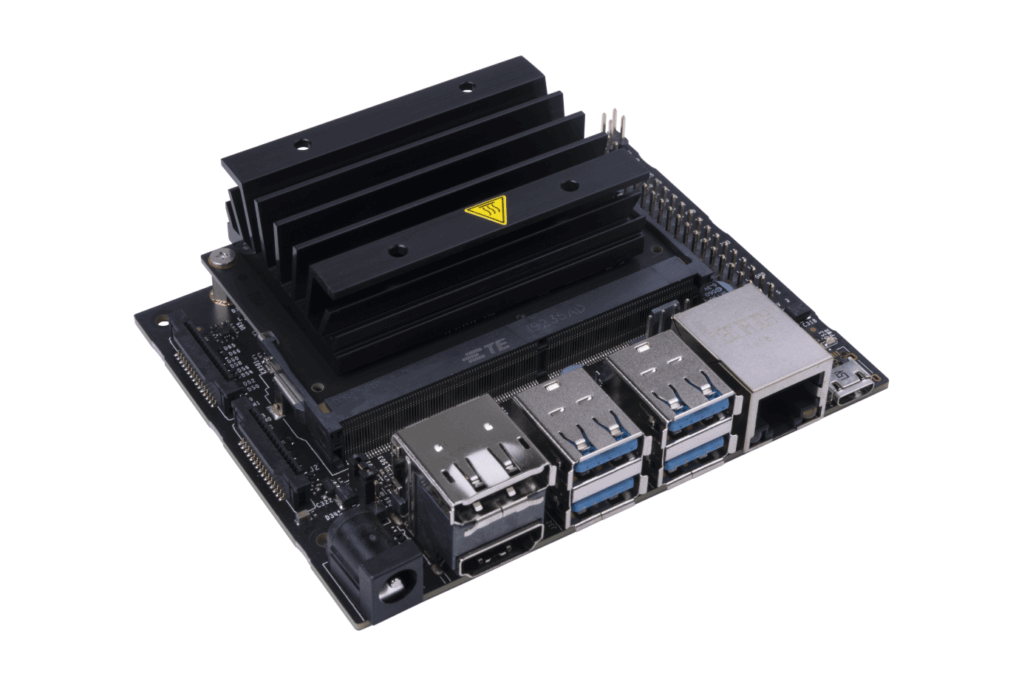
Looking to do AI and machine learning but want to use your SBC as a desktop at the same time? Or simply want a more affordable AI & machine learning option? The Jetson Nano from NVIDIA can do just that!
The NVIDIA® Jetson Nano™ Developer Kit delivers computing performance to run modern AI workloads at an unprecedented size, power, and cost. Developers, learners, and makers can now run AI frameworks and models for applications like image classification, object detection, segmentation, and speech processing.
Despite having an older and weaker core than some of the SBCs currently, the Jetson Nano has a much more capable GPU and performance designed specifically for AI applications. If you are looking for an SBC for AI and machine learning purposes while also using it as a general-purpose computer, the Jetson Nano would be your pick!
NVIDIA® Jetson Nano™ Developer Kit Specs:
CPU: Quad-core ARM® A57 CPU
GPU: 128-core NVIDIA Maxwell™ GPU
RAM: 4 GB 64-bit LPDDR4
Price: $89
Jetson Nano Alternatives: reComputer J1010 & J1020
The reComputer J1010 and J1020 are hand-size edge AI boxes, built with the Jetson Nano production module, rich set of IOs, aluminum case, passive heatsink, and pre-installed JetPack System, ready for your next AI application development and deployment.
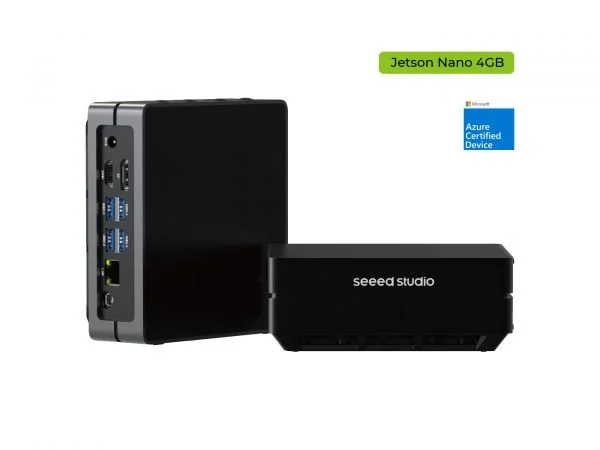
A fully comprehensive specs sheet and comparison between J1010 and J1020 can be found here.
Get your reComputer J1010 and J1020 now on Seeed’s online store!
Upgrade from Jetson Nano: NVIDIA® Jetson Xavier™ NX Developer Kit
Machine learning is no longer exclusive to powerful desktops and clusters! The NVIDIA® Jetson Xavier™ NX Developer Kit, released in 2020, brings supercomputer performance to the edge with specialized hardware for artificial intelligence.
The new Jetson Xavier accelerates the NVIDIA software stack in as little as 10 W with more than 10X the performance of its widely adopted predecessor, Jetson TX2. With its small form factor and power-efficient performance, the Jetson Xavier enables solutions with accurate, multi-modal AI inference that opens the door for new breakthrough products.
If you’re looking to build machine learning-powered applications like object detection, image segmentation, or natural language processing, you won’t go wrong with the NVIDIA® Jetson Xavier NX.
NVIDIA® Jetson Xavier NX Developer Kit Specs:
CPU: 6-core NVIDIA Carmel ARM®v8.2 64-bit CPU 6MB L2 + 4MB L3 Cache
GPU: NVIDIA Volta architecture with 384 NVIDIA CUDA® cores and 48 Tensor cores
RAM: 8GB 128-bit LPDDR4x @ 51.2GB/s
AI Performance: 6 TFLOPS (FP16), 21 TOPS (INT8)
Price: $399
Find out more at Seeed’s online store now!
Jetson Xavier NX Alternatives: reComputer J2011, J2012 & J2021
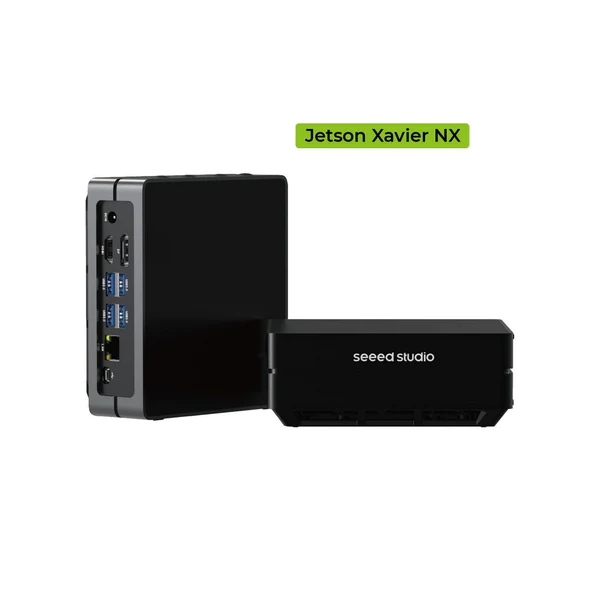
The reComputer J2011, J2012, and J2021 are hand-size edge AI boxes, built with Jetson Xavier NX 8GB/16GB module, rich set of IOs, aluminum case, cooling fan, pre-installed JetPack System, ready for your next AI application development and deployment.
A fully comprehensive specs sheet and comparison between J1010 and J1020 can be found here.
Get your reComputer J2011, J2012, and J2021 on Seeed’s online store now!
For Industrial AI Application: Jetson AGX Xavier H01 Kit
The Jetson AGX Xavier H01 Kit is powered by an NVIDIA Jetson AGX Xavier processor, which applies AI performance and delivers up to 32 Tera Operations Per Second(TOPs) yet costs less than 30W. Supported by NVIDIA JetPack and DeepStream SDKs, as well as Linux OS, NVIDIA CUDA®, cuDNN, and TensorRT software libraries, the kit makes AI-powered autonomous machines possible. It is an ideal solution for agriculture, optical inspection, manufacturing, robotics, logistics, retail, service, smart cities, and healthcare.
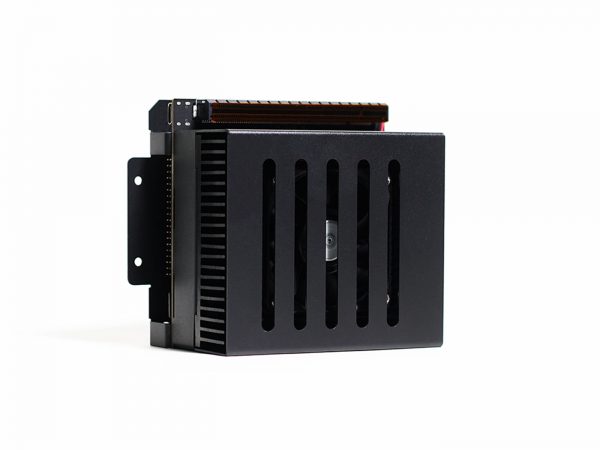
The Jetson AGX Xavier H01 Kit provides a full-featured development platform designed to get you up and running quickly. The included carrier board exposes many standard hardware interfaces, enabling a highly flexible and extensible platform for rapid prototyping. With the 32GB eMMC 5.1 and 256-Bit LPDDR4x 136.5GB/s in memory, it can be leveraged by the developers to store multiple AI models, run complex applications, and enhance real-time pipelines. As part of the world’s leading AI computing platform, it benefits from the rich set of NVIDIA AI tools and workflows, enabling developers to train and deploy neural networks quickly.
Jetson AGX Xavier H01 Kit Specs:
CPU: 8-core Carmel ARM v8.2 64-bit CPU, 8MB L2 + 4MB L3
GPU: 512-core Volta GPU with 64 Tensor Cores 11 TFLOPS (FP16) 22 TOPS (INT8)
RAM: 32GB 256-Bit LPDDR4x @ 136.5GB/s
Price: $1,499
You can check out Jetson AGX Xavier H01 Kit on Seeed’s online store now!
Most Powerful, Compact, Energy-Efficient: NVIDIA® Jetson AGX Orin™ Developer Kit
NVIDIA® Jetson AGX Orin™ Developer Kit provides a giant leap forward for Robotics and Edge AI. With up to 275 TOPS of AI performance and power configurable between 15W and 50W, you now have more than 6X the performance of NVIDIA® Jetson AGX Xavier™ in the same compact form factor for developing advanced robots and other autonomous machine products.
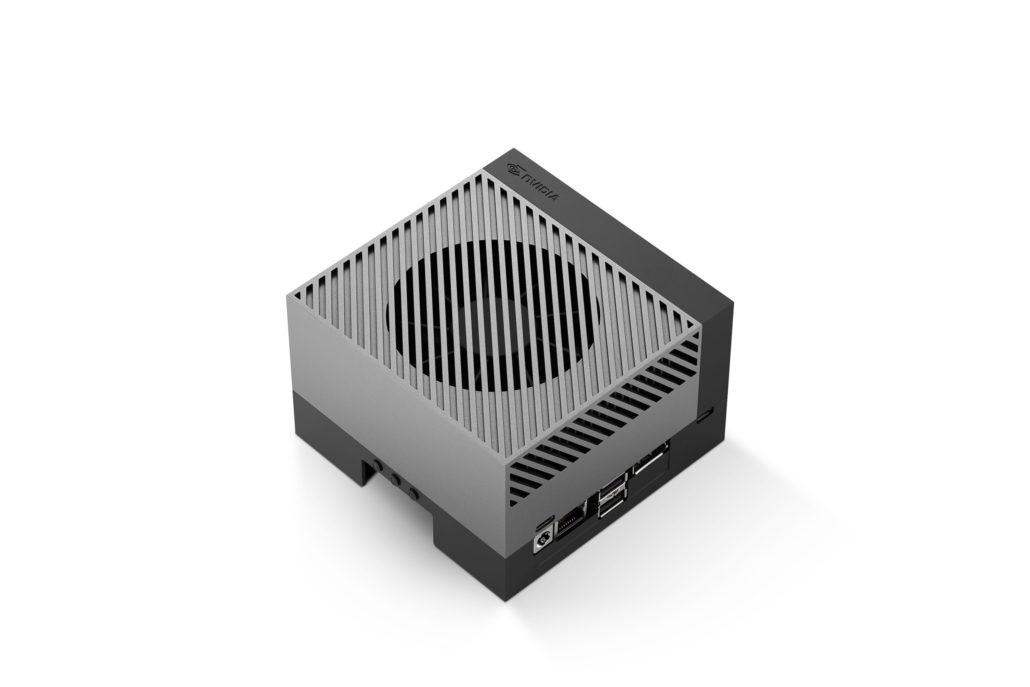
The kit contains a Jetson AGX Orin module with heat sink and reference carrier board, 802.11ac/abgn wireless Network Interface Controller, USB-C power adapter, and cord, together with a quick start and support guide. It features an NVIDIA Ampere architecture GPU and Arm Cortex – A78AE CPU, together with next-generation deep learning and vision accelerators. High-speed IO, 204GB/s of memory bandwidth, and 32GB of DRAM are capable of feeding multiple concurrent AI application pipelines. With Jetson AGX Orin, developers can now deploy large and complex models to solve problems like natural language understanding, 3D perception, and multi-sensor fusion.
NVIDIA® Jetson AGX Orin™ Developer Kit Specs:
CPU: 12-core Arm® Cortex®-A78AE v8.2 64-bit CPU 3MB L2 + 6MB L3
GPU: NVIDIA Ampere architecture with 2048 NVIDIA® CUDA® cores and 64 Tensor Cores
RAM: 32GB 256-bit LPDDR5 @204.8GB/s
Price: $1,999
Get yours now on Seeed’s online store!
Best for Machine Learning with TensorFlow: Coral Dev Board
Looking to run machine learning with an SBC with TensorFlow? The Google Coral Dev Board will definitely do the trick!
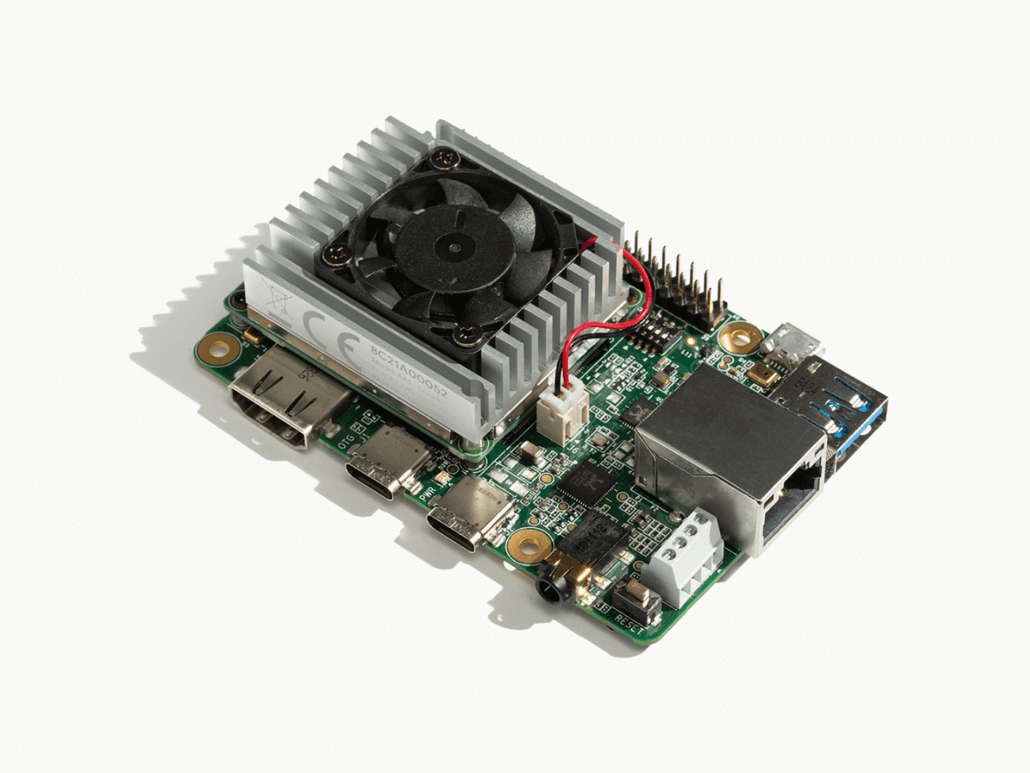
For those who do not know what TensorFlow is, it is an end-to-end open-source platform for machine learning. It has a comprehensive, flexible ecosystem of tools, libraries, and community resources that lets researchers push the state-of-the-art in ML and developers easily build and deploy ML-powered applications.
This SBC was designed especially for use with TensorFlow Lite machine learning models! However, this may be bad news for users who want to use other deep learning frameworks like Pytorch, Caffe / Caffe2, etc. The Coral Dev Board features an Edge TPU module engineered to deliver high-performance machine learning interpretation, which allows users to quickly prototype on-device Machine Learning products.
With one of the newest CPUs, the NXP i.MX 8M SOC (Quad-core Cortex-A53, plus Cortex-M4F), combined with the Edge TPU, offers incredible performance and power while being power efficient. However, the Coral Dev Board comes with a heavy price tag costing $149.99. It also lacks a desktop operating system if you are looking for an SBC that can run as a desktop. Nonetheless, if you wish to do machine learning on an SBC with Tensorflow, the Coral Dev board will definitely get the job done.
Coral Dev Board Specs:
CPU: NXP i.MX 8M SOC (Quad Cortex-A53, Cortex-M4F)
GPU: Integrated GC7000 Lite GraphicsRAM: 4GB LPDDR4
AI Accelerator: Google Edge TPU ML Accelerator Coprocessor (4TOPS)
Price: $169.99
ARM Alternatives
After seeing multiple SBCs running on the ARM architecture family, such as the Raspberry Pi and Jetson series, we will now take a look at SBCs with a different type of processor – the X86.
The main difference between an ARM and an X86 CPU would be X86 targets performance, while ARM focuses on energy efficiency. So if you are looking for non-ARM SBCs, the following 2 SBCs are highly recommended.
PC and Dev Board in One: ODYSSEY – X86J4125864
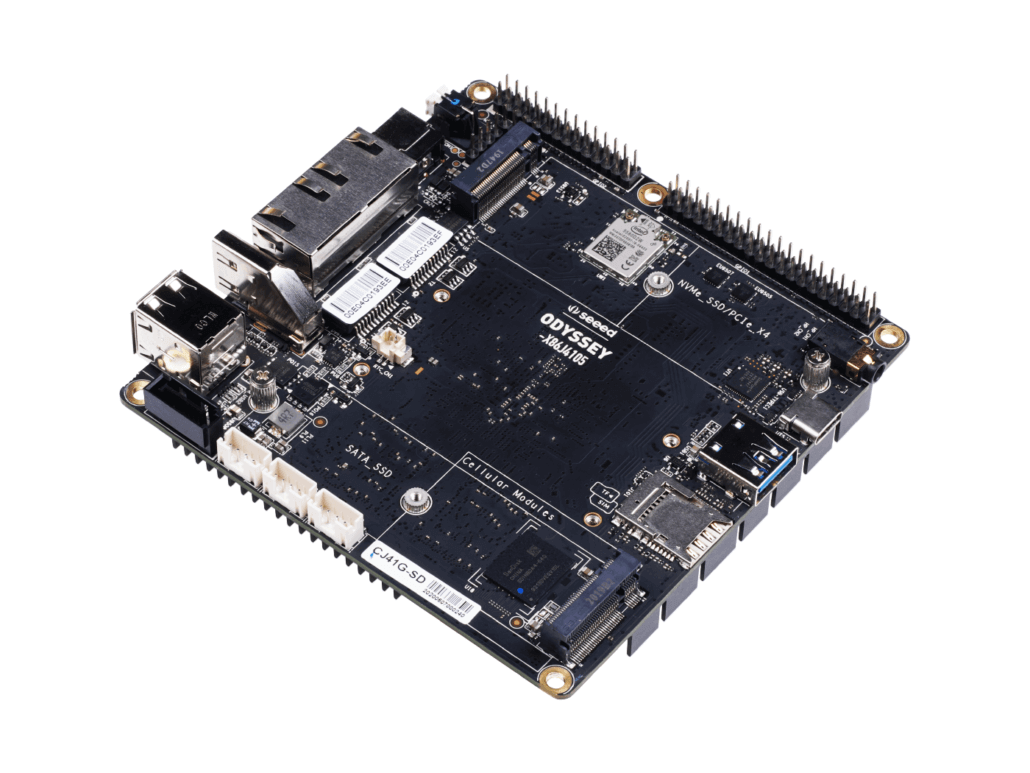
If you want a powerful board that is able to run a full version of Windows 10, the Odyssey-X86J4125864 is definitely the board for you.
ODYSSEY is a series of SBCs allowing you to build Edge Computing applications with ease. The ODYSSEY – X86J4125, which is based on Intel Celeron J4105, is a Quad-Core 2.0GHz CPU that bursts up to 2.7GHz. There is also an onboard ATSAMD21 Core, an ARM Cortex-M0+ MCU that allows you to program Arduino on the x86 platform. It includes all the powerful features of a Mini PC, such as 8GB LPDDR4 RAM, 64GB eMMC Storage, onboard Wi-Fi/BLE, Dual Gigabyte Ethernet Ports, Audio Input and Output, USB Ports, HDMI, SATA Connectors and PCIe, however, within a cost-effective price.
With simple connections to Mouse, Keyboard, and Monitor to ODYSSEY – X86J4125, you will get a Desktop Mini PC right away. With eMMC versions, you even have the Windows 10 Enterprise pre-installed!
Read more about it from this blog post as it answers the common Q&A about this product!
An in-depth youtube review and demo can be found here!
ODYSSEY – X86J4105800 Specs:
CPU: Intel® Celeron® J4125, Quad-Core 2.0-2.7GHz w ATSAMD21 ARM® Cortex®-M0+ Coprocessor
GPU: Intel® UHD Graphics 600
RAM: LPDDR4 8GB Storage
Price: $215 – 298
Learn more at Seeed’s online store.
Affordable Mini Server for a home cloud experience: ZimaBoard 832-X86
ZimaBoard 832 model is a single board server equipped with Intel Celeron N3450 Quad Core operating at 1.1GHz to 2.2GHz, which contains both the expandability of an x86 SBC and the standard function of a microserver. It can be applied as a personal Network Attached Storage managing 4TB cloud charging free, and the contribution is simplified that can be easily set up in 5 minutes. Meanwhile, the storage data traffic in the high-security single path by the configured highly concealed performance VPN. The user can apply it as a software router by tuning the network with OpenWrt and pfSense wirelessly. Through internet streaming, the single board server has the ability to display a 4K resolution ratio at 60Hz, which means it can be built as an extra media server running with Plex.
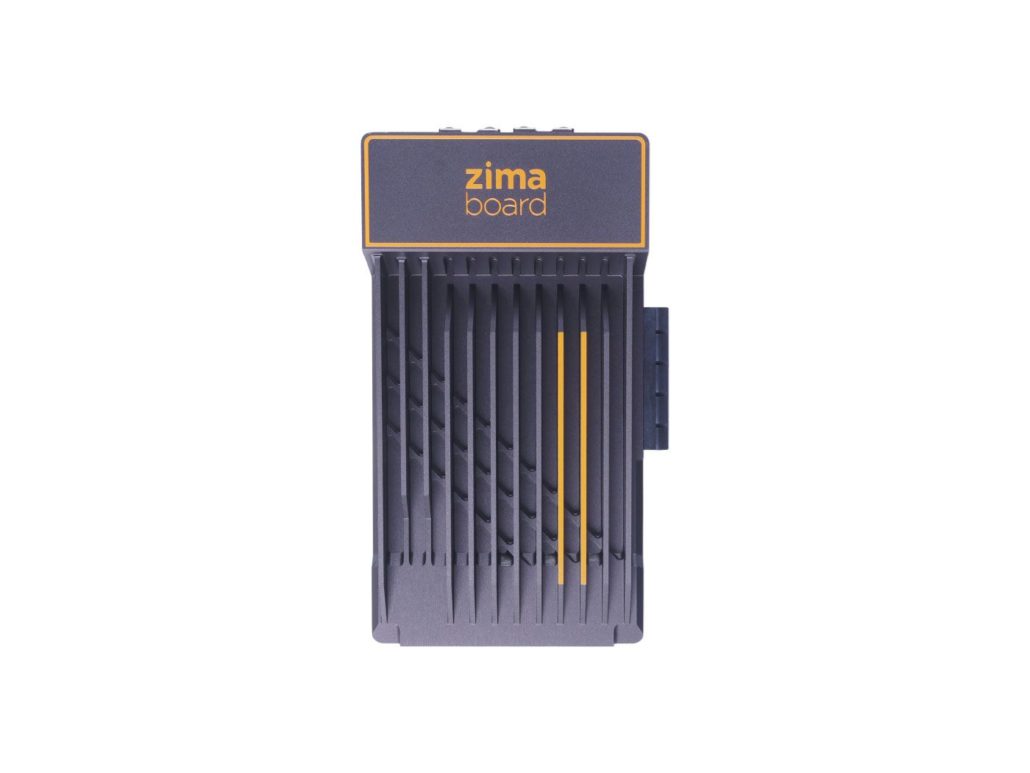
With outstanding performance, the ZimaBoard single-board server has very low energy consumption while it only costs 6W in Thermal Design Power. It has presented a unique physical structure designed for passive cooling.
ZimaBoard 832-X86 Specs:
CPU: Intel Celeron N3450 Quad-Core @1.1 – 2.2GHz
GPU: Intel® HD Graphics 500 – 200MHz Base Frequency | 700MHz Burst
RAM: 8G – 3200MHz LPDDR4, dual-channel
Price: $199.90
Get yours now on Seeed’s online store.
Best for Industrial IoT – BeagleBone® Green Wireless
Moving back to ARM SBCs, BeagleBone® Green Wireless is the collaborative effort between Seeed Studio & BeagleBone.org. It offers a Wi-Fi and BLE solution with a built-in 2.4 GHz TI WLinkTM8 module with two antennas while supporting AP+STA communication and complying with Bluetooth Advanced Audio Distribution Profile. All these features make the BeagleBone® Green Wireless the perfect SBC for bringing your systems online for IoT.
In addition, the board also comes with two Grove connectors, allowing you to easily interface with the many available Grove modules, like sensors or other communication modules. If you want to build a cloud-connected monitoring or communication system, BBGW is going to be the obvious choice!
BeagleBone® Green Wireless Specs:
CPU: AM3358 1GHz ARM® Cortex-A8
Coprocessor: 2x PRU 32-bit microcontrollers
RAM: 512MB DDR3
Price: $52.90
Learn more at Seeed’s online store now!
Best For Intermediate & Above Developers: Rock960
The Rock960 is a fully-fledged development platform for vision projects using Android and Linux-based distributions. Intermediate and above developers will likely find the Rock960 to be a good blend of price to functionality, especially when you factor in the Open AID firmware, which acts as a bridge between most popular Machine Learning frameworks and hardware.
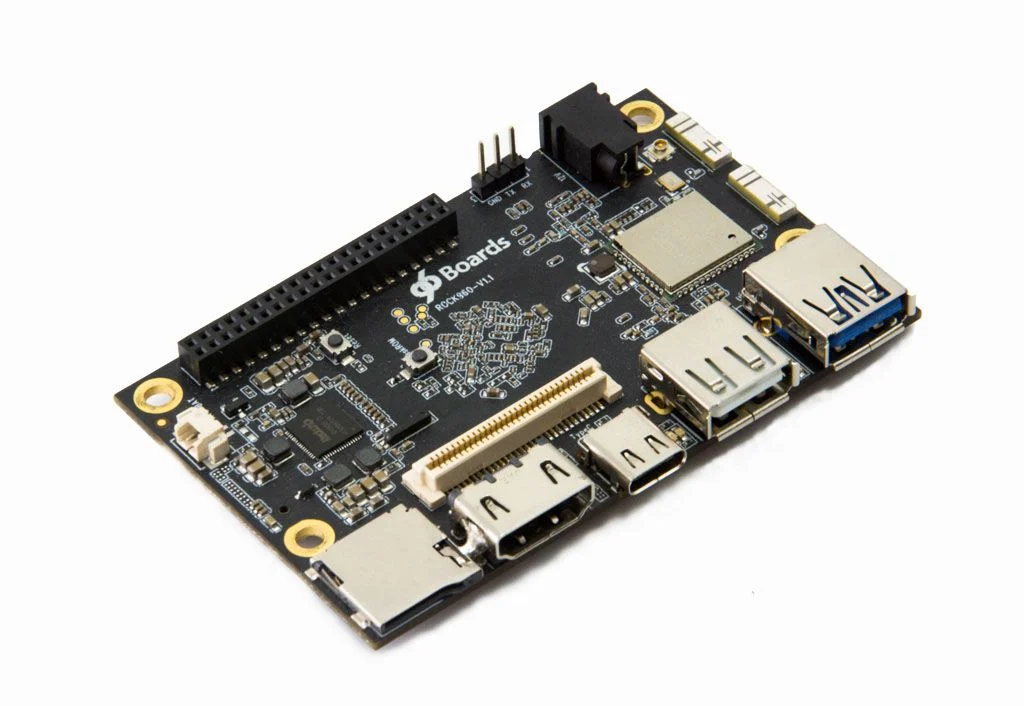
The ROCK960 is the first 96board based on a Rockchip processor. Featuring RK3399 with Dual A72 plus Quad A53 cores and Mali T860MP4 makes it one of the most powerful 96boards. This board provides enough I/O for learning every aspect of the SoC, so it could be a great board for learning about development on a multi-core ARM platform.
Rock960 Specs:
CPU: ARM Cortex-A72 2-core up to 1.8GHz + Cortex A53 4-core up to 1.4GHz
GPU: ARM Mali-T860 MP4 with OpenGL ES 1.1 to 3.2 support, OpenVG1.1, OpenCL 1.2 and DX 11 support
RAM: 2GB DDR3
Price: $99
More information on Rock960 can be found on Seeed’s online store!
Performance and Power Saving: Radxa Rock Pro
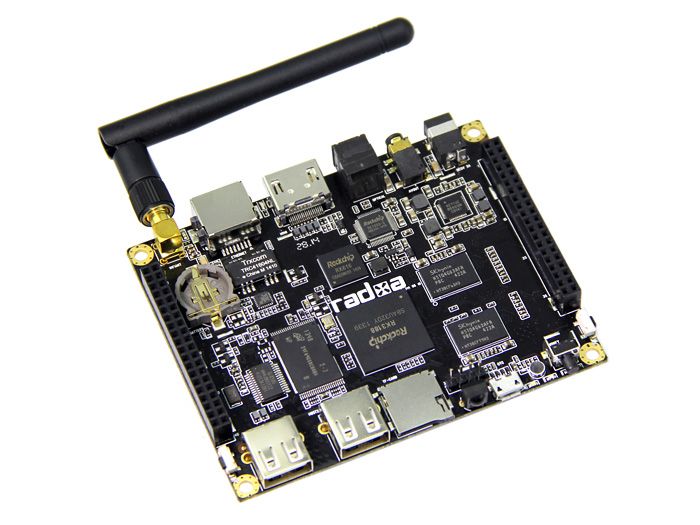
The CPU is ARM Cortex-A9 processor running from 324Mhz to 1.6Ghz and can balance between performance and power saving. It integrates with full interfaces, all ways to connect like Wifi, Bluetooth, HDMI, USB, Spdif, MIC, and TF Card.
As a barebones single-board computer, the key feature for 80 pins 2.54mm extension headers, you can easily connect rock with a breadboard or other sensor boards.
Radxa Rock Pro Specs:
CPU: ARM Cortex-A9 4-core @ 1.6 GHz
GPU: Mali400-mp4 @ 533Mhz, OpenGL ES 2.0
RAM: 2GB DDR3 @ 800Mhz
Price: $97.75
Get yours now on Seeed’s online store!
Best for Smart Voice and Sound Applications: Respeaker Core v2.0
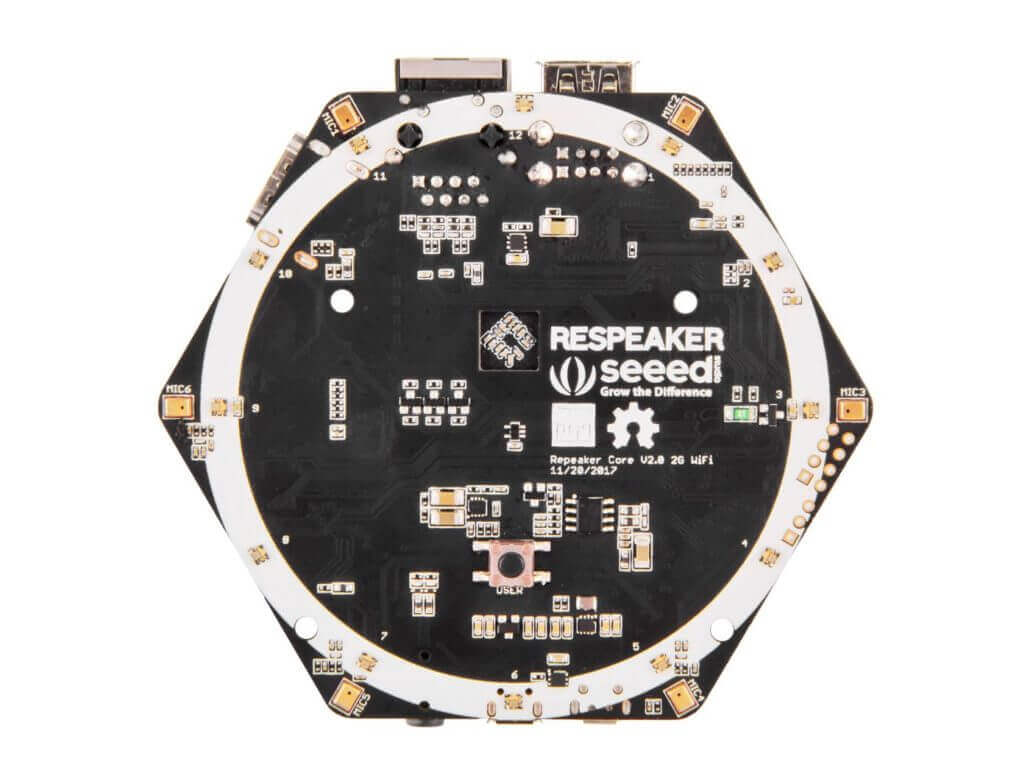
Looking for a board to make a smart speaker, intelligent voice assistant system, voice recorder, car voice assistant, or basically any smart voice and sound applications? This SBC right here is perfect for all these applications.
The ReSpeaker Core v2.0 allows developers to create powerful and impactful voice and sound interfaces. Suitable to use as a base for smart assistance as well as responding to environmental sounds, the ReSpeaker Core v2.0 was designed with the idea that developers deserve to have many options available to them.
This SBC is able to run and support Debian and Android with an onboard microphone array and software-based voice enhancement algorithms. Around the core are peripherals, including a Kingston 4GB eMMC to enable the OS to run onboard, a WiFi/BLE module, USB, Grove, HDMI connectors, onboard 6-mic array, LED ring, and more.
Furthermore, the Respeaker Core v2.0 is able to process audio received through the 6 far-field microphones in real time with the powerful Axol Core. You can get all this goodness inside this SBC at only $99.
Respeaker Core v2.0 Specs:
CPU: Quad-Core Cortex-A7 @ Up to 1.5GHz
GPU: Mali 400MP, Supports OpenGL ES1.1/2.0
RAM: 1GB RAM (Core Module includes RAM and PMU)
Price: $99
Get yours now on Seeed’s online store!
Digital Signage and AI applications: Lenovo Leez SBC P710
Lenovo Leez SBC P710 is the first single-board computer with android 9.0 support. Equipped with an RK3399 6-core 64-bit chip solution, the frequency up to 2.0GHz, with 2GB/4GB LPDDR4 memory, storage can be extended to 512GB. Equipped with 3G and 4G data communication interface, USB3.0, PCIe m. 2, Type-c, DP 1.2 high-performance data transmission, and display interface, supports dual-channel camera and dual-channel 4K output. The form factor is 85mm x 85mm. It is capable of implementing AI algorithms to meet the requirements in a variety of scenarios, such as digital signage, innovative retail, computer vision, and more.
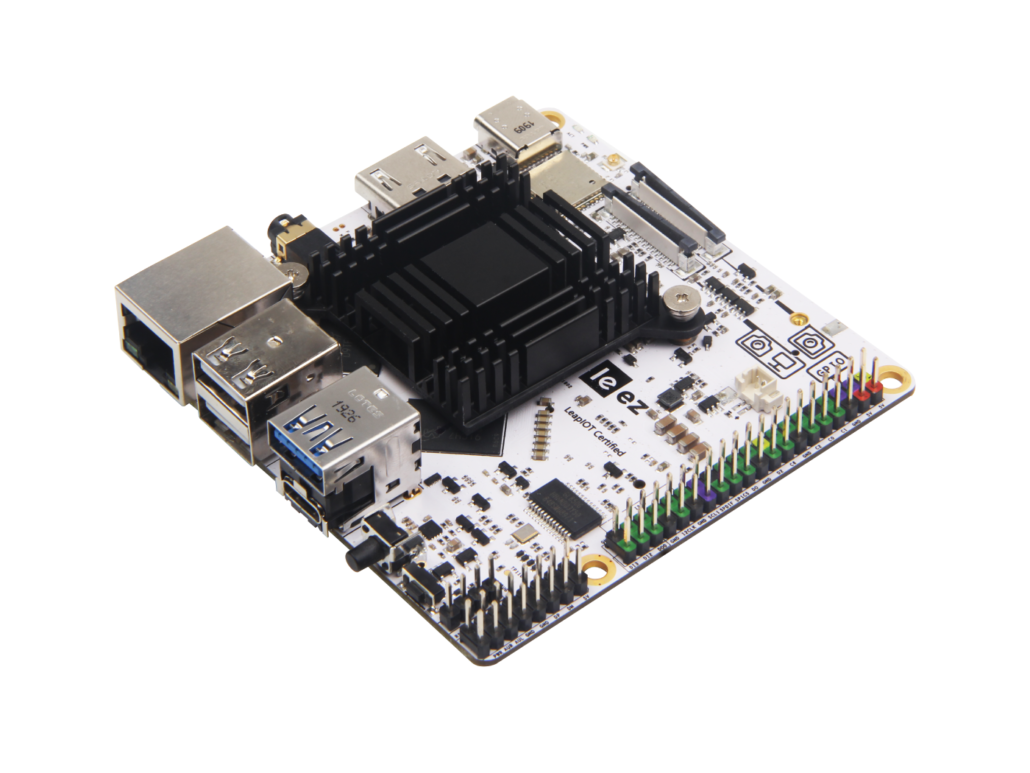
With native on-device AI processing power and official Android 9.0 Pie support, the Leez P710 can tackle AI making, such as machine learning and image identification. Similarly, digital signage projects are a breeze with its optional 4G LTE add-on, camera module, and 10.1-inch touchscreen.
Lenovo Leez SBC P710 Specs:
CPU: Rockchip RK3399
GPU: Mali-T860 MP4 GPU
RAM: 4GB LPDDR4
Price: $199
Get yours now on Seeed’s online store!
Running Android: Hikey 970 Development Board
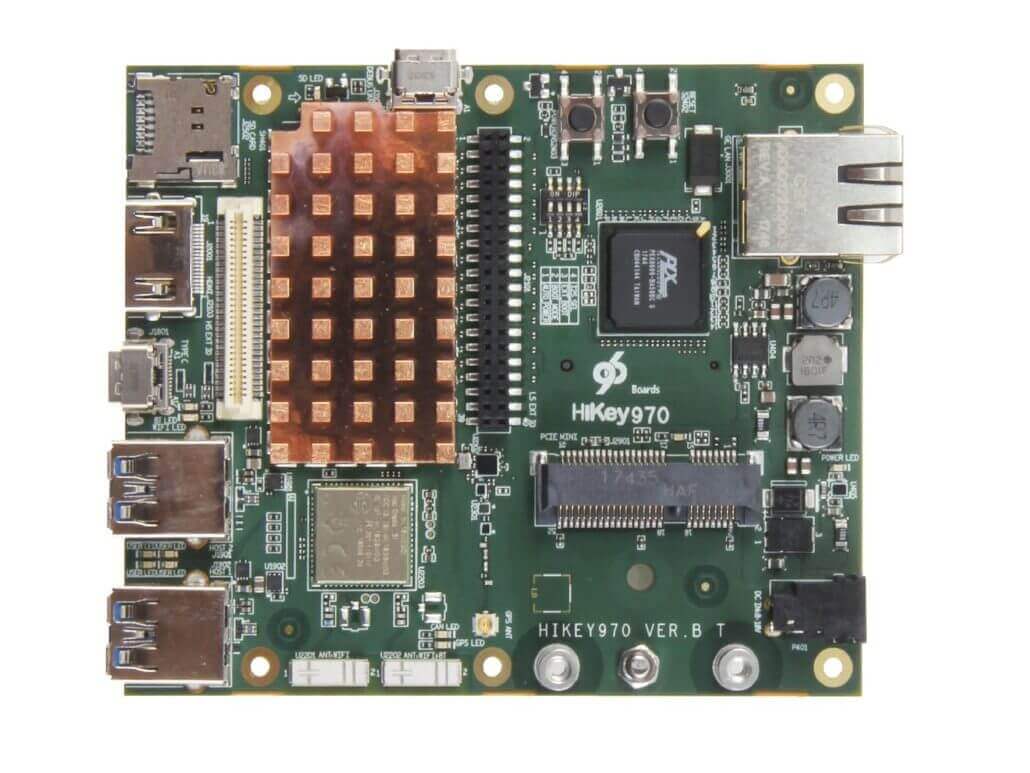
Do you wish to run Android on an SBC together with Machine learning capabilities? With the Hikey 970, the board can run Android (AOSP) or Linux distributions (Ubuntu/Debian) and supports Huawei HiAI SDK that delivers up to 25x performance and 50x power efficiency for A.I. applications.
The latest HiAI SDK V150 supports Caffe, TensorFlow, TensorFlow Lite, Android NN frameworks, and various tools. Making use of the LPDDR4X 1866MHz memory and featuring 64GB of UFS 2.1 storage, Bluetooth, WIFI, and GPS, this is a board specifically aimed at developers, especially those looking to maximize accelerated AI capabilities that are not present in most other development platforms.
This makes the Hikey 970 to be used in most applications like Deep Learning, Robots, Automobile, and Smart City. However, at a price of $299, it is one of the most expensive SBCs out there in the market, but it will definitely be worth it with its performance.
Hikey 970 Development Board Specs:
CPU: 4-Core Cortex A73 @ 2.36GHz, 4-Core Cortex A53 @ 1.8GHz
GPU: Mali G72-MP12
RAM: 6GB LPDDR4
Price: $299
Get yours today on Seeed’s online store!
Running Linux: NPi i.MX6ULL Dev Board
Lastly, we have the NPi i.MX6ULL Dev Board, a low-power consumption Linux SBC built around the powerful i.MX6ULL, with a frequency of up to 800MHz. You would love the onboard 512MB DDR3L and 8GB eMMC, not to mention the rich interfaces and I/O resources.
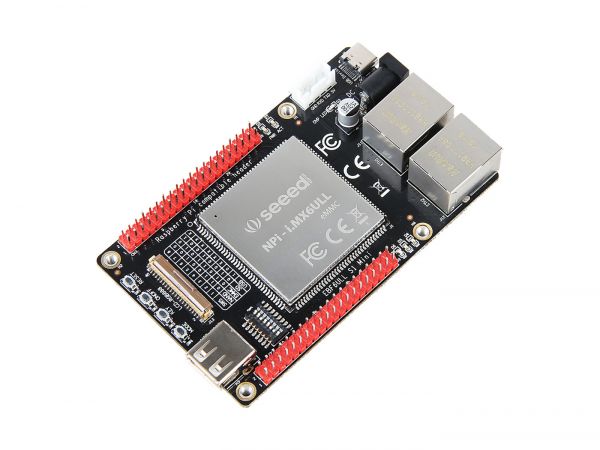
The breakout board mainly includes various peripheral interfaces and input and output. Including but not limited to two 100M Ethernet ports, one USB Host and one USB device port, one 24bit RGB LCD Interface, 2x 40 Pin I/O expansion header, etc. A wealth of resources to meet your various control needs. All those features make it a perfect solution for industrial control, rail transit, drone control, audio output, etc.
Main applications are:
- Industrial (CAN-Ethernet gateways etc)
- White goods (refrigerators, Type-c waves, etc)
- Smart Home Devices
NPi i.MX6ULL Dev Board – Linux Specs:
CPU: NXP MCIMX6Y2CVM08AB
GPU: –
RAM: 512MB DDR3L
Price: $49
Learn more about it on Seeed’s online store!
Summary
That’s it for the best Single Board Computers of 2022! With so many SBCs being released each year, it is hard to keep track of all of them. Single Board Computers each have their own various functions like machine learning and education each with different prices as well! So do pick out wisely which SBC suits your projects the most to make the most out of it.
Still struggling in making a decision? To make it easier for you guys, we have compiled them into a table for you to easily compare their differences and pick your favorite:
| SBC | CPU | GPU | RAM | Price |
| Raspberry Pi 4 | Broadcom BCM2711, Quad core cortex-A72 (ARM v8) 64-bit SoC 1.5GHz | Broadcom VideoCore VI | 1GB, 2GB, 4GB, 8GB LPDDR4 SDRAM | $35 (1GB) $45 (2GB) $55 (4GB) $75 (8GB) |
| Raspberry Pi Zero / Zero W | 1GHz, Single Core CPU | – | 512MB RAM | $5 and $10 |
| reTerminal CM4104032 | Broadcom BCM2711 4-core Cortex-A72 (ARM v8) | – | 4GB LPDDR4 with on-die ECC | $195 |
| ODYSSEY – STM32MP157C | Dual-core Arm Cortex-A7 @ 650MHz with Arm Cortex-M4 Coprocessor MPU | – | 512MB DDR3 | $54.90 |
| Rock Pi 4 Model B | Dual Cortex-A72, frequency 1.8Ghz with quad Cortex-A53, frequency 1.4Ghz | Mali T860MP4 GPU, supports OpenGL ES 1.1 /2.0 /3.0 /3.1 /3.2, Vulkan 1.0, Open CL 1.1 1.2, DX11. | 64bit dual channel LPDDR4@3200Mb/s, | $49 (1GB) $59 (2GB) $75 (4GB) |
| Banana Pi M64 | Allwinner 64 Bit Quad Core ARM Cortex A53 1.2 GHz | Dual-core Mali 400 MP2 | 2GB DDR | $60 |
| Orange Pi 4 | Rockchip RK3399 6-core ARM® 64-bit processor, up to 2.0GHz | Mali-T864, Supports OpenGL ES1.1/2.0/3.0/3.1, OpenVG 1.1, OpenCL, DX11, AFBC | Dual 4GB LPDDR4 | $35 |
| NVIDIA® Jetson Nano™ Developer Kit | Quad-core ARM® A57 CPU | 128-core NVIDIA Maxwell™ GPU | 4GB 64-bit LPDDR4 | $89 |
| reComputer J1010 | Quad-core ARM® A57 CPU | 128-core NVIDIA Maxwell™ GPU | 4GB 64-bit LPDDR4 | $199 |
| reComputer J1020 | Quad-core ARM® A57 CPU | 128-core NVIDIA Maxwell™ GPU | 4GB 64-bit LPDDR4 | $259 |
| NVIDIA® Jetson Xavier NX Developer Kit | 6-core NVIDIA Carmel ARM®v8.2 64-bit CPU 6MB L2 + 4MB L3 Cache | NVIDIA Volta architecture with 384 NVIDIA CUDA® cores and 48 Tensor cores | 8GB 128-bit LPDDR4x @ 51.2GB/s | $399 |
| reComputer J2011 | 6-core NVIDIA Carmel ARM®v8.2 64-bit CPU 6MB L2 + 4MB L3 Cache | NVIDIA Volta architecture with 384 NVIDIA CUDA® cores and 48 Tensor cores | 8GB 128-bit LPDDR4x @ 51.2GB/s | $599 |
| reComputer J2012 | 6-core NVIDIA Carmel ARM®v8.2 64-bit CPU 6MB L2 + 4MB L3 Cache | NVIDIA Volta architecture with 384 NVIDIA CUDA® cores and 48 Tensor cores | 16 GB 128-bit LPDDR4x @ 59.7GB/s | $699 |
| reComputer J2021 | 6-core NVIDIA Carmel ARM®v8.2 64-bit CPU 6MB L2 + 4MB L3 Cache | NVIDIA Volta architecture with 384 NVIDIA CUDA® cores and 48 Tensor cores | 8 GB 128-bit LPDDR4x @ 59.7GB/s | $599 |
| Jetson AGX Xavier H01 Development Kit | 8-core Carmel ARM v8.2 64-bit CPU, 8MB L2 + 4MB L3 | 512-core Volta GPU with 64 Tensor Cores, 11 TFLOPS (FP16), 22 TOPS (INT8) | 32GB 256-Bit LPDDR4x @ 136.5GB/s | $1,499 |
| NVIDIA® Jetson AGX Orin™ Developer Kit | 12-core Arm® Cortex®-A78AE v8.2 64-bit CPU 3MB L2 + 6MB L3 | NVIDIA Ampere architecture with 2048 NVIDIA® CUDA® cores and 64 Tensor Cores | 32GB 256-bit LPDDR5 @204.8GB/s | $1,999 |
| Coral Dev Board | NXP i.MX 8M SOC (quad Cortex-A53, Cortex-M4F) | Integrated GC7000 Lite Graphics | 1GB LPDDR4 | $149.99 |
ODYSSEY x86J4105864 | Intel® Celeron® J4105 1.5 GHz (2.5 GHz boost) w ATSAMD21G18 Cortex® M0+ Coprocessor | Intel® UHD Graphics 600 | 8GB LPDDR4 | $218 |
| ZimaBoard 832 – X86 | Intel Celeron N3450 Quad-Core @1.1 – 2.2GHz | – | 8GB LPDDR4, dual channel | $199.90 |
| BeagleBone® Green Wireless | AM3358 1GHz ARM® Cortex-A8 with 2x PRU 32-bit microcontroller coprocessors | – | 512MB DDR3 | $52.90 |
| Rock960 | ARM Cortex-A72 2-core up to 1.8GHz + Cortex A53 4-core up to 1.4GHz | ARM Mali T860MP4 | 2GB LP DDR3 | $99 (2GB) $139 (4GB) |
| Radxa Rock Pro | ARM Cortex-A9 4-core @ 1.6 GHz | Mali400-mp4 @ 533Mhz, OpenGL ES 2.0 | 2GB DDR3 | $97.75 |
| Respeaker Core v2.0 | Quad-Core Cortex-A7, up to 1.5GHz | Mali400MP, Supports OpenGL ES1.1/2.0 | 1GB RAM | $99 |
| Lenovo Leez SBC P710 | Rockchip RK3399 | Mali-T860 MP4 | 4GB LPDDR4 | $199 |
| Hikey 970 Development Board | 4 x Cortex A73 @ 2.36GHz, 4 x Cortex A53 @ 1.8GHz | Mali G72-MP12 | 6GB LPDDR4 | $299 |
| NPi i.MX6ULL Dev Board – Linux | NXP MCIMX6Y2CVM08AB | – | 512MB DDR3L | $49 (eMMC) $45 (NAND) |
What are your thoughts on all these Single Board Computers? Did we miss any Single Board Computers that you think deserve to be on this list? We’d love to hear from you guys, so let us know in the comments!